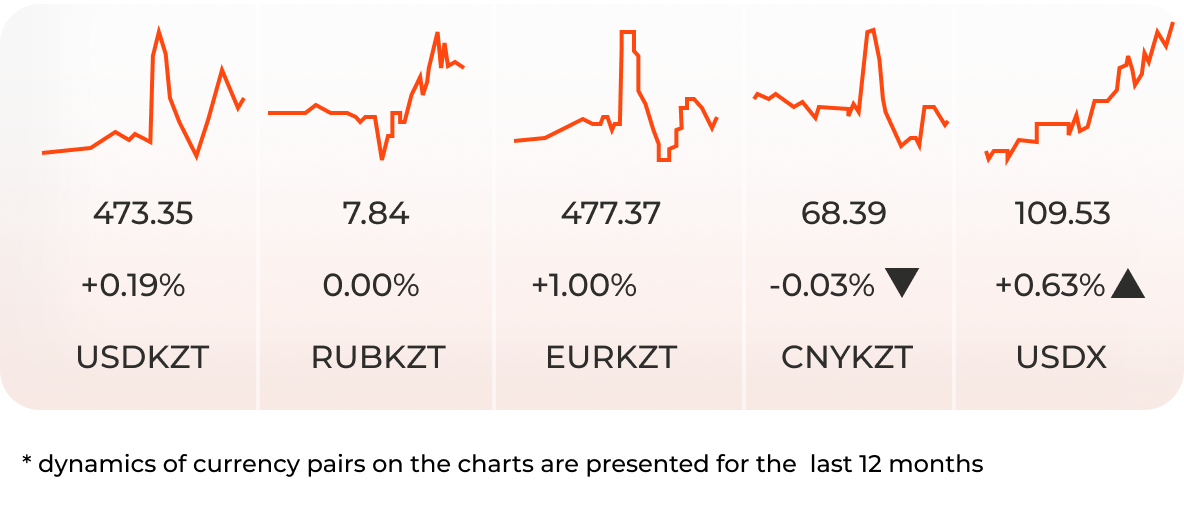
Last week, the national currency weakened against the dollar (-0.19%) and the euro (-1.0%), but there is a slight strengthening of the exchange rate against the yuan (+0.03%). It is also noteworthy that the ruble exchange rate remained at the same level – 7.84 tenge. Since the beginning of the year, the tenge has weakened against the dollar by 9.62%, against the ruble – by 36.11%, against the yuan by – 0.57%, but strengthened by 2.4% against the euro.
The weekly volatility of the tenge exchange rate has increased against foreign currencies: it was 0.4% against the dollar, and the ruble – 0.8%. During the week, the national currency weakening occurred mainly at a low trading volume on the stock exchange, as well as a decline in oil prices and the Dollar Index by the end of the week.
The USDKZT pair trading volume over the past week increased by 129.7% compared to the previous one (a decrease of 29.7% compared to the average weekly trading volume in 2022) and amounted to $ 403.53 million. The doubled volumes are since the previous week was short and followed the tax one.
The Tenge Index
The Tenge Index decreased by 0.2% over the week, by 12.6% since the beginning of the year and amounted to 79.32 points.
The weakening of the tenge is due to the continued decline in oil prices to 88-92 dollars per barrel (-0.9% per week). At the same time, the dollar fell by 0.6% to 108.97 points over the week and eased slightly the pressure on the currencies of developing countries, including the tenge.
In August-September of this year, the Tenge Index stabilized at the 77-80 points level. Over the same period, the fundamental factors have changed significantly: oil quotes decreased by 16.2%, and the Dollar Index increased by 2.9%. The tenge exchange rate against the Russian ruble stimulates the reduction of volatility and the weak sensitivity of the Tenge Index to changes in fundamental factors. Recall that the share of the ruble in the Index is 25%. At the same time, the ruble to tenge exchange rate depends on the ruble to the dollar exchange rate, which is currently being formed on not free foreign exchange market and non-market conditions.
Last week, the curve of oil prices (adjusted to the base period of the end of 2018) converged with the Dollar Index curve. The last time such a convergence of the two curves was observed in January 2021, when oil quotes rose to $ 60 per barrel against the backdrop of Joe Biden’s inauguration, and the Dollar Index was stable. Now the reasons are completely different: the convergence was forced by the global dollar strengthening and the decline in oil prices.
Jusan Analytics Opinion
As observed last week, tenge weakening was due to the continued decline in oil prices and the growth of expectations for the Dollar Index strengthening as a result of the Fed’s statements about a further significant rate hike.
Given the recent Decision of the National Bank of the Republic of Kazakhstan to keep monetary conditions at the same level despite the acceleration of inflation observed in August and the fact that the peak of inflation has not been passed, the tenge exchange rate will be under inflationary pressure. Thus, internal and external investors will invest a great risk premium in the tenge exchange rate, thereby contributing to the depreciation of the tenge against other currencies.
The increase in the tenge exchange rate volatility against foreign currencies last week indicates an increase in the currency expectations uncertainty of market participants.
In addition to the influence of fundamental external factors, the subsequent trend of the exchange rate will largely depend on the measures of the authorized authorities. At the same time, in the absence of additional shocks, the expected dynamics of external factors pull the tenge exchange rate down.

